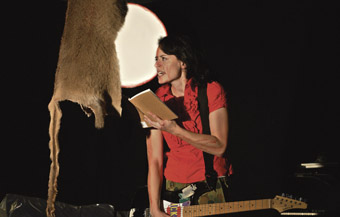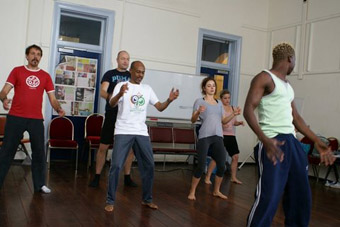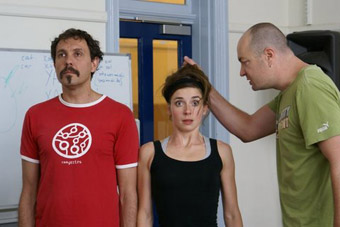intensive research, enriched development
urszula dawkins: watdi, perth

Deborah Robertson, Prompter Live Studio Development, 2010, Hydra Poesis
photo Traianos Pakioufakis
Deborah Robertson, Prompter Live Studio Development, 2010, Hydra Poesis
THE WESTERN AUSTRALIAN THEATRE DEVELOPMENT INITIATIVE (WATDI) IS NOW IN THE SECOND YEAR OF ITS PILOT PROGRAM, WITH 2010 APPLICATIONS CURRENTLY AT THE SHORTLIST STAGE AND THREE SUCCESSFUL APPLICANTS FROM 2009 WELL ADVANCED IN THEIR CREATIVE DEVELOPMENTS.
Funded by the Australia Council, WATDI’s formal structure is of particular interest for two reasons: its five-stage, consultative application process, and a seemingly unique management partnership of three key players in Perth’s contemporary performing arts scene: Perth Institute of Contemporary Arts (PICA), The Blue Room and ArtRage.
According to PICA Director Amy Barrett-Lennard, WATDI is currently the only significant provider of development funding for new theatre in WA, following the demise of the state government’s Major Production Fund. The scheme’s particular aim has been the encouragement of artists to engage in intensive research and creative development, without necessarily focusing on performance outcomes. It offers amounts of $30,000, $60,000 or $90,000 to assist successful applicants to achieve their goals.
To this end, in 2009-10 local companies Hydra Poesis, pvi collective, and a Sudanese-Australian theatre exploration, The Shrouds or the Dead, have each been fortunate to explore, research and develop work, not only free from the pressure of producing a show, but actively encouraged to ‘think big’ along the way.
Hydra Poesis received $60,000 to develop Prompter Live Studio. The work takes place in three locations simultaneously, with three completely separate audiences linked by interconnected studio installations. It follows the evolving relationship between a foreign correspondent and their local ‘fixer;’ explores a surreal prisoner-exchange; and enters the performative world of the lone video blogger.
Prompter Live Studio’s development team includes Hydra Poesis Director Sam Fox, co-writer Patrick Pittmann and sound artist David Miller, with performers Deborah Robertson, Michelle Robin Anderson and Brendan Ewing. The WATDI grant, in addition to buying development time, has enabled the team to work with mentor Dicky Eton of UK performance group Pacitti Company, live forum TV producer Richard Fabb and writer/dramaturg Stephen Sewell.
Working with these artists, says Fox, has helped the team develop a deep understanding of how Prompter Live Studio’s blend of performance material and technical approach might work with more traditional ideas of storytelling. The project, he says, has been an opportunity that other forms of funding could not have adequately supported.
“One of the things the WATDI process is trying to be true to,” he says, “is the idea of this being a predominantly research and development process, and not turning it into a creative development where we try and produce as much of the work as we can.”
He believes that without the WATDI funding, Hydra Poesis could not have undertaken the research: “We would have made an attempt at the work but…it’s a really ambitious project, and thematically and conceptually it requires a lot of development.” He also feels that the standard “bums on seats” requirement would have precluded it from other current funding options.
WATDI’s five-stage application process begins with a one-page proposal. Shortlisted applicants are interviewed by panellists from the three partner organisations, and a further shortlist is invited to develop proposals further, and provided with $3000 to do so. In-depth discussion then takes place with the panel, this time including an additional, ‘external’ member. Stage five is the funding announcement and from here on, the degree of communication is largely up to the grant recipients.
All the partner organisations see this process as a chance for artists to discuss and develop their proposals in a supportive environment. Fox agrees that rigorous discussion of the proposal at interviews helped Hydra Poesis to refine and develop their proposal. Both Fox and PICA’s Performance Program Manager, Vernon Guest, acknowledge the care with which the artist–funder relationship needs to be managed, however, particularly in a small arts environment where ‘everyone knows everyone.’
Guest says the structure continues to evolve in the current round, with the panel working to achieve the ideal balance between ‘arm’s length’ and ‘responsive’ approaches. The benefit of more communication with artists lies in greater sharing of expertise and advice, and a more supported structure. At the same time, a major benefit of less contact is the minimisation of administration costs. Guest cites some organisations as carrying around 15% of administration costs, partly due to the need for project officers to be constantly communicating with artists. WATDI is currently running at around five to seven percent administration costs.
Both PICA’s Amy Barrett-Lennard and The Blue Room’s Louise Coles comment that one of WATDI’s unexpected positives has been the developing relationship between the three partner organisations. The work of running WATDI is divided according to resources, for example PICA takes care of marketing and communications, as it is well set up to do this.This ‘piggy-backing’ of WATDI requirements onto existing infrastructure is also significant in keeping costs down.

Workshop, The Shrouds or the Dead
Hydra Poesis is nearing the end of its WATDI development, and plans to produce a ‘test’ version of Prompter Live Studio in 2011. Other recipients in 2009, pvi collective, used their WATDI funding to research and develop Transumer, an ‘augmented reality’ work using iPhones, currently running as part of 17th Biennale of Sydney. The Shrouds or the Dead, based on a play by Sudanese-Australian writer Afeif Ismail, took the form of a three-week intensive development in which performers, musicians and a translator joined Ismail in exploring the ‘transcreation’ of his work to an Australian, multicultural context, examining how Sudanese performance tradition could inform and be informed by other methods, including Butoh.

Workshop, The Shrouds or the Dead
ArtRage Festival Director, Marcus Canning, speaks positively about the applications in the current WATDI round: although they were fewer in number, he says, the quality this year was higher overall, with greater diversity and some very strong regional proposals. The point of the initiative, he reasserts, is “development unshackled from the needs of set production outcomes.”
“There is a sense in the second year that there is a growing understanding of what this can mean,” Canning says, “and more key practitioners putting forward a greater array of expansive and brave development ideas.”
It appears WATDI’s impact is threefold: strengthening the research focus of the companies involved through the critical feedback process (a process, it should be noted, that extends not only to successful applicants); providing WA’s theatre sector with an important new opportunity to develop work at a deep level; and building relationships between the organising partners. The Australia Council for the Arts will soon receive reports from WATDI on its first year of operation; then it will begin to make its own assessment of the initiative. Meanwhile, it will be interesting to see what emerges from the 2010 application round.
The Western Australian Theatre Development Initiative (WATDI) is funded by the Australia Council for the Arts and driven by partners PICA, The Blue Room and ArtRage. WADTI: www.watdi.org.au; Hydra Poesis: hydrapoesis.net; pvi collective: www.pvi.com; The Shrouds or the Dead: http://shroudsorthedead.wordpress.com/about/
RealTime issue #97 June-July 2010 pg. 30






